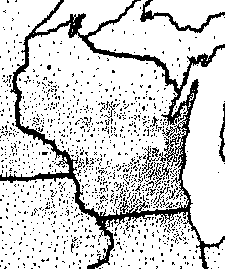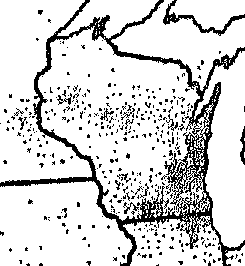1933 Wisconsin milk strike facts for kids
The 1933 Wisconsin milk strike was a series of protests by dairy farmers in Wisconsin. They worked together to try and get a better price for their milk during a tough time called the Great Depression. There were three main strike periods in 1933. Each one lasted longer and saw more conflict.
A group called the Cooperative Milk Pool tried to work with bigger farmer groups. These included the National Farm Holiday Association and the Wisconsin Farmers' Holiday Association. But each time, the bigger groups ended their strikes early. This left the Milk Pool to continue its protest alone.
Contents
Why Farmers Went on Strike
In the late 1920s, farmers got a good share of the money from milk sales. For every 100 pounds of milk, they received about $4.79. Farmers got 46% of this money.
But between 1930 and 1933, the price dropped a lot. Farmers only got about $3.48 for 100 pounds of milk. Their share of the money also went down to 30.5%. This, plus the hard times of the Great Depression, made it very difficult for small farmers.
Farmers who sold milk for bottling in cities did okay. But those who sold milk for making cheese or butter became very poor. Milk for bottling sold for about $1.50 per hundred pounds. Milk for cheese and butter factories only got $0.85 per hundred pounds. This caused some disagreements between different types of dairy farmers. The strikes mostly affected milk going to factories, not milk for bottling.
In the 1930s, Wisconsin was the biggest milk producer in the United States. The 1930 census showed over 125,000 dairy farms in the state. Most of Wisconsin's farmland was used for dairy farming.
How the Strikes Happened
At first, farmers simply refused to sell their milk. They wanted a price of $1.50 for every hundred pounds. But they soon realized many farmers were still selling milk at lower prices.
So, the strikers started setting up roadblocks. They stopped milk delivery trucks from reaching factories. If a truck refused to turn back, the farmers would pour the milk out onto the road. In the early strikes, trucks just found different routes.
Later, strikers drove around looking for trucks. They would force them to turn back. Sometimes, if they couldn't stop a delivery, they would put things like kerosene or oil into the milk. In a few cases, there were even explosions at milk factories.
The state government tried to get milk to market. They broke up roadblocks or sent police to protect milk convoys. They used tear gas to break up large groups of farmers. In one case, guardsmen with bayonets made farmers leave their spots. Trains were also used to get around roadblocks. But some train lines were blocked, and milk was even dumped from trains in one yard.
Other farmer groups in the Midwest were also protesting milk prices. The "Farmers Holiday" organization worked with a group called The United Farmers League. These groups had done strikes for other farm products too. The Farmers Holiday group helped the Wisconsin milk strikes by organizing similar protests in other states. They tried to make the strikes more effective across state lines.
The February Strike
The first strikes happened from February 15 to 22. They were mostly in the Fox Valley area. This was where the Wisconsin Cooperative Milk Pool, led by Walter M. Singler, was strongest.
The first conflict happened near Appleton, Wisconsin. Guards protecting a milk convoy threw heavy objects at about 100 strikers.
The May Strike
The second set of strikes took place from May 13 to 19. These protests spread to more parts of Wisconsin. There was also more conflict than in the February strike.
In Shawano County, a newspaper reported that 30 people were hurt. This happened when National Guard members, acting as deputies, clashed with picketing farmers. The farmers won this fight. They dumped the milk and made the deputies retreat by throwing back their own tear gas bombs.
On May 16, 1933, National Guardsmen with bayonets and tear gas forced farmers from a protest spot in Waukesha County.
About 25,000 pounds (11,340 kg) of milk were ruined with kerosene at a factory near Farmington in Jefferson County.
On May 16, a guardsman injured two teenagers. One of them died after they did not stop their vehicle in Racine County.
On May 18, a farmer in his 50s died. He either fell or was pushed from a milk truck after it left a protest roadblock. This happened between Saukville and Grafton in Ozaukee County.
On May 19, the Milk Pool made a temporary agreement with the state government. They agreed to talk about ways to end the strikes. The Milk Pool wanted five things:
- First, for the National Guard to leave the protest areas.
- Second, to end the two-price system for milk.
- Third, to reorganize the Department of Agriculture.
- Fourth, to stop large chain stores from making and processing food.
- Fifth, for dairy farmer organizations to be officially recognized.
The October-to-November Strike
The third series of strikes happened from October 21 to November 18. These protests affected an even larger part of Wisconsin.
Milk factories near Plymouth and Fond du Lac, Wisconsin were damaged by explosions around November 1, 1933. A cheese factory near Belgium, Ozaukee County, Wisconsin was destroyed by an explosion and fire. This was the fourth such incident that week. Factories in Krakow and Zachow, in Shawano County, Wisconsin, were also damaged by explosions on November 3, 1933. In total, seven factories were damaged, and thousands of pounds of milk were dumped.
On October 28, 1933, a 60-year-old farmer died at a protest line in the Town of Burke, Wisconsin. A person in a car stopped by the crowd fired a single bullet. The farmer who died was not part of the protest. He was there delivering food to the strikers. The person who fired the shot was angry because a striker had broken their car's headlight earlier. The shooter later admitted guilt and was sentenced to prison for a crime related to the death.
What Happened Next?
Local newspapers reported that farmers lost $10 million during the strikes. After 1933, Singler's Cooperative Milk Pool bought milk factories. This was meant to help its members earn more money. But the Milk Pool eventually became less important. The economy slowly got better, which helped smaller farmers earn more. It is not clear if the strikes directly caused this improvement.
Important People Involved
- Walter M. Singler: Leader of the Wisconsin Cooperative Milk Pool.
- Albert G. Schmedeman: The Governor of Wisconsin at the time.
- Milo Reno: President of the National Farm Holiday Association.
- Arnold Gilberts: President of the Wisconsin Farmers' Holiday Association.
|



